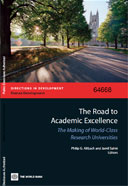Building World Class Universities
In a global economy that depends on sophisticated innovation and knowledge to drive growth and wealth, a new World Bank report on higher education suggests that low- and middle-income countries should resist the temptation to establish world-class universities to cash in on research earnings and court global prestige before educating their own citizens to high tertiary standards.
Although unlimited money and attracting the world’s best and brightest students and teachers helps strengthen a country’s bid to create a world-class university, strategic vision and leadership are also vital, without which national aspiration to a world-class university ranking falls short.
World class universities thrive in environments that foster competitiveness, unrestrained scientific inquiry and academic freedom, critical thinking, innovation, and creativity. Moreover, institutions that have complete autonomy are also more flexible because they are not bound by cumbersome bureaucracies and externally imposed standards, even in light of the legitimate rules and statutes that bind them. As a result, they can manage their resources with agility and quickly respond to the demands of a rapidly changing global market.
Building and operating world-class universities can cost millions of dollars. For example, in late 2007, Saudi Arabia announced plans for a new $10 billion graduate research university; Pakistan plans to spend $750 million for each of its new universities of engineering, science, and technology during the next few years; and the school of medicine established by Cornell University in Qatar in 2002 cost $750 million. The availability of abundant money and international prestige creates a virtuous circle that allows elite universities to attract more top professors and researchers, as is often the case for leading U.S. colleges.
Recent years of global economic crisis, though, have significantly affected research universities, potentially boosting East Asia’s universities. East Asian countries have weathered the economic storm better than their Western counterparts, as they seek to join the top ranks of the global research elite. For example, India has increased its higher education investment by 31% since 2010, and China has continued to fund its excellence programs in support of the nation’s leading universities.

